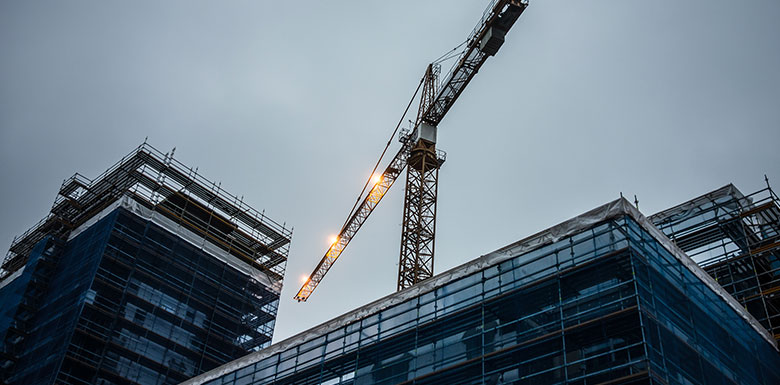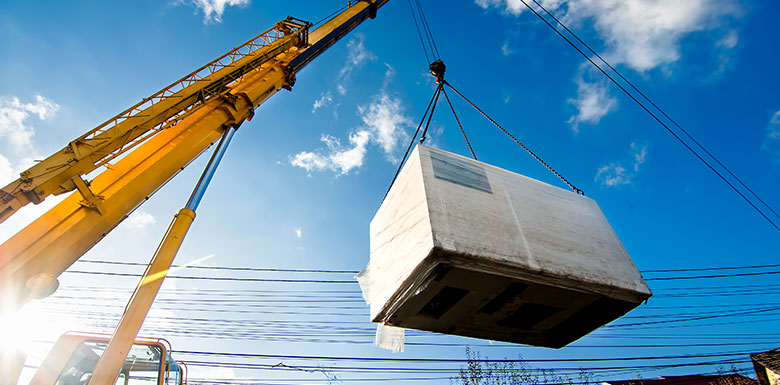NYC Crane Accident Statistics
The U.S. Bureau of Labor and Statistics (BLS) tracks the frequency of crane accidents and some common causes:
- Approximately 3,380 nonfatal injuries from 2015 to 2020 resulted crane accidents.
- Annually, almost one-quarter of crane deaths occur in the manufacturing sector and around one-third are in the transportation of goods and materials. Of the deaths in transportation, over 50% of fatalities were crane operators.
- Falls from a crane account for around 14% of all fatalities every year.
Kinds of Cranes in NYC
There are three basic kinds of cranes found in New York City.
Climbing Cranes
Climbing cranes, also known as tower cranes, are essential for high-rise building construction.
These cranes are built alongside the structures they are helping to erect and can rise as the building increases in height.
Their ability to reach great heights and lift heavy loads makes them indispensable on any major skyscraper project.
Reasons for Collapse
- Overloading: Exceeding the crane’s weight capacity can lead to structural failure.
- Improper Assembly: Errors during the assembly or adjustment of the crane can compromise its stability.
- Base Instability: An unstable base or inadequate anchoring can cause the crane to topple.
Stationary Cranes
Stationary cranes are fixed to a single location and are widely used for projects where heavy lifting is concentrated in a specific area.
These cranes have a strong base that supports their operation and are ideal for lifting tasks that require high precision and stability, such as in industrial settings or for large-scale assembly operations.
Reasons for Collapse
- Mechanical Failure: Breakdown of critical components such as the boom or jib can lead to collapses.
- Weather Conditions: High winds or sudden storms can overwhelm the crane’s design limits.
- Foundation Issues: Weaknesses in the crane’s foundation can lead to a collapse if not properly checked.
Traveling Cranes
Traveling cranes, or mobile cranes, are versatile and can be moved around a site or between different locations.
These cranes come in various forms, including truck-mounted cranes and crawler cranes.
Their mobility allows for flexible positioning and is particularly useful in projects that span large areas or require lifting operations at multiple sites.
Reasons for Collapse
- Uneven Terrain: Moving over rough or uneven ground can destabilize the crane.
- Operational Errors: Incorrect crane operation or maneuvering can lead to accidents.
- Mechanical Degradation: Regular wear and tear without proper maintenance can cause unexpected failures.
Causes of NYC Crane Accidents
Common causes of crane accidents include:
Insufficient Training
Whenever someone isn’t given proper training to operate a crane safely, the likelihood of an accident increases. Without the right training, an operator might not know how to react to a hazard, making it worse. They may not even know how they caused an accident.
Operator Error
The human element on a worksite means there will always be a chance for accidents. If an operator misjudges, mishandles, or miscalculates while they’re using a crane, there could be catastrophic consequences.
Mechanical Failure or Defective Equipment
Some crane accidents are caused because their parts fail or the equipment was defective to start with. Worn-out cables, broken safety devices, or weak structures could lead to accidents and injuries that could be prevented.
Operator Fatigue
Like other vehicles, using a crane requires focus and care. Whenever an operator is tired or fatigued, their judgment is impaired and their reaction times are slowed.
Crane operators are more likely to have an accident if they don’t get enough rest.
Overloading – Even At Less Than “Maximum” Capacity
According to the National Institute of Occupational Safety and Health (NIOSH), each crane has a maximum loading capacity, and crane operators and companies must always stay aware of this maximum capacity to avoid exceeding it.
A crane that attempts to lift or lower a load too heavy for its maximum capacity is clearly overloaded and can easily collapse.
However, some cranes collapse under the weight of loads that are less than the crane’s stated capacity.
Due to the risk of collapse, NIOSH recommends that any lift weighing 70 percent or more of the crane’s total capacity be treated as a “critical lift,” with extra safety precautions taken to prevent collapse.
It’s important to examine whether a crane operator and the contractors on site were taking extra precautions during a critical lift.
Lack of Control Over the Hoisted Load
Federal work safety researchers also note the risks that come with lack of proper control over a hoisted load. A load that swings or rocks can easily collapse a crane.
It can also cause other damage, such as hitting workers who are on scaffolding or who are located near the crane or the path of the swinging load.
Crane operators who are not properly trained or who are distracted while operating the crane increase the risk of loss of control.
Extending the Crane Too Far
Just as a crane has a maximum load limit, it has a maximum distance it can reach before it becomes unbalanced or collapses.
Cranes come in many different designs: some can move under their own power, while others must be towed.
Some cranes are designed for land use only, while others can be used on the deck of a ship.
These and other factors all affect how a crane “behaves” in any given setting – and how far it can reach before it collapses.
Hidden Weaknesses or Defects in the Crane
Not all crane collapse accidents result from the carelessness of crane operators.
The collapse may result from hidden weaknesses or damage in the crane’s structure, defective maintenance or repair, or defective parts used in a proper repair.
These “hidden dangers” can cause a crane collapse that even the most careful operator could not have foreseen or prevented.
Failure to Communicate Properly With Crane Operators or Ground Crews
Many serious crane accidents are caused by miscommunication rather than collapse. A lack of clear communication can make any site a dangerous worksite.
According to NIOSH, crane operators and ground crew should learn a set of standardized hand gestures for communicating with one another about the crane’s operation.
Gestures include signs for raising and lowering the load, raising and lowering the boom, stopping, and moving more slowly. Crane riggers are frequently injured in construction site accidents because of lack of good communication.
However, communication is only as good as the people who are paying attention to it. Crane operators sitting in elevated cabs may lose sight of a spotter or rigger. When crane operators or ground crew become distracted or use the wrong signals, disaster may result.
Tell Us What Happened
"*" indicates required fields

